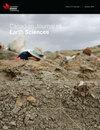Lower and Upper Ordovician conodont biostratigraphy and revised lithostratigraphy in the fault and fold zones of the Boothia Uplift, south-western Boothia Peninsula, Nunavut
IF 1.6
4区 地球科学
Q3 GEOSCIENCES, MULTIDISCIPLINARY
引用次数: 0
Abstract
The strata exposed near Pasley Bay on south-western Boothia Peninsula were previously named the Franklin Strait Formation, spanning Lower Ordovician through early Silurian and dissected by two disconformities. The interpretation of the age and correlation were based on limited fossil evidence. New detailed field investigations and sampling at the Pasley Bay section resulted in a finding of over 1000 identifiable conodont specimens representing 37 species among 28 genera. Five Lower Ordovician and four Upper Ordovician North American standard conodont Zone-equivalent faunas are documented from the section, namely: Lower Ordovician Cordylodus angulatus, Rossodus manitouensis, Acodus deltatus/ Oneotodus costatus, Oepikodus communis, Reutterodus andinus, and Upper Ordovician Belodina confluens, Oulodus velicuspis, Oulodus robustus, and Amorphognathus ordovicicus Zone-equivalent faunas. These faunas enable a new understanding of the age and stratigraphic position of the Franklin Strait Formation: (1) it is now correlated to the Turner Cliffs (upper part of lower member and upper member), Ship Point, Thumb Mountain, Irene Bay, and Allen Bay (lower member) formations straddling Lower to upper Upper Ordovician with the Middle and lower Upper Ordovician missing; (2) it biostratigraphically overlaps with the simultaneously named Netsilik Formation for the strata containing the Cordylodus angulatus, Rossodus manitouensis, Acodus deltatus/Oneotodus costatus, and lower Oepikodus communis Zone-equivalent faunas, and lithostratigraphically for the upper part of lower member and upper member of the Turner Cliffs Formation and lower Ship Point Formation. This study also provides stratigraphic support for the tectonic model that advocates the Boothia Uplift to be a deep-seated, east-dipping thrust block. Additionally, the conodont Colour Alteration Index is used to estimate the increased heat effects close to the fault zones in the environs of the Boothia Uplift.努纳武特布西亚半岛西南部布西亚隆起断褶带下、上奥陶统牙形石生物地层学与修正岩石地层学
在布西亚半岛西南部帕斯利湾附近出露的地层以前被命名为富兰克林海峡组,该地层跨越下奥陶统至早志留世,被两个不整合面所切割。对年龄和相关性的解释是基于有限的化石证据。在帕斯利湾剖面进行了新的详细的实地调查和采样,结果发现了1000多个可识别的牙形石标本,代表28属中的37种。该剖面记录了5种下奥陶统和4种上奥陶统北美标准牙形刺区等效动物,即:下奥陶统Cordylodus angulatus、Rossodus manitouensis、delodus / Oneotodus costatus、Oepikodus communis、Reutterodus andinus和上奥陶统Belodina confluens、Oulodus velicuspis、Oulodus robustus和Amorphognathus ordovicicus区等效动物。这些动物群使人们对富兰克林海峡组的时代和地层位置有了新的认识:(1)它与特纳悬崖组(下段上部和上段上部)、船角组、大拇指山组、艾琳湾组和艾伦湾组(下段)相对应,这些组横跨上奥陶统下至上奥陶统,上奥陶统中下奥陶统缺失;(2)在含Cordylodus angulatus、Rossodus manitouensis、Acodus deltatus/Oneotodus costatus和下部Oepikodus communis带等效动物群的地层上,与同时命名的Netsilik组有生物地层学上的重叠;在岩石地层学上与特纳崖组下段、上段和船点组下部有岩石地层学上的重叠。该研究也为布西亚隆起为深埋东倾逆冲地块的构造模式提供了地层支持。此外,牙形石变色指数用于估计布西亚隆起周围断裂带附近热效应的增加。
本文章由计算机程序翻译,如有差异,请以英文原文为准。
求助全文
约1分钟内获得全文
求助全文
来源期刊

Canadian Journal of Earth Sciences
地学-地球科学综合
CiteScore
2.80
自引率
7.10%
发文量
66
审稿时长
6-12 weeks
期刊介绍:
The Canadian Journal of Earth Sciences reports current research in climate and environmental geoscience; geoarchaeology and forensic geoscience; geochronology and geochemistry; geophysics; GIS and geomatics; hydrology; mineralogy and petrology; mining and engineering geology; ore deposits and economic geology; paleontology, petroleum geology and basin analysis; physical geography and Quaternary geoscience; planetary geoscience; sedimentology and stratigraphy; soil sciences; and structural geology and tectonics. It also publishes special issues that focus on information and studies about a particular segment of earth sciences.
 求助内容:
求助内容: 应助结果提醒方式:
应助结果提醒方式:


